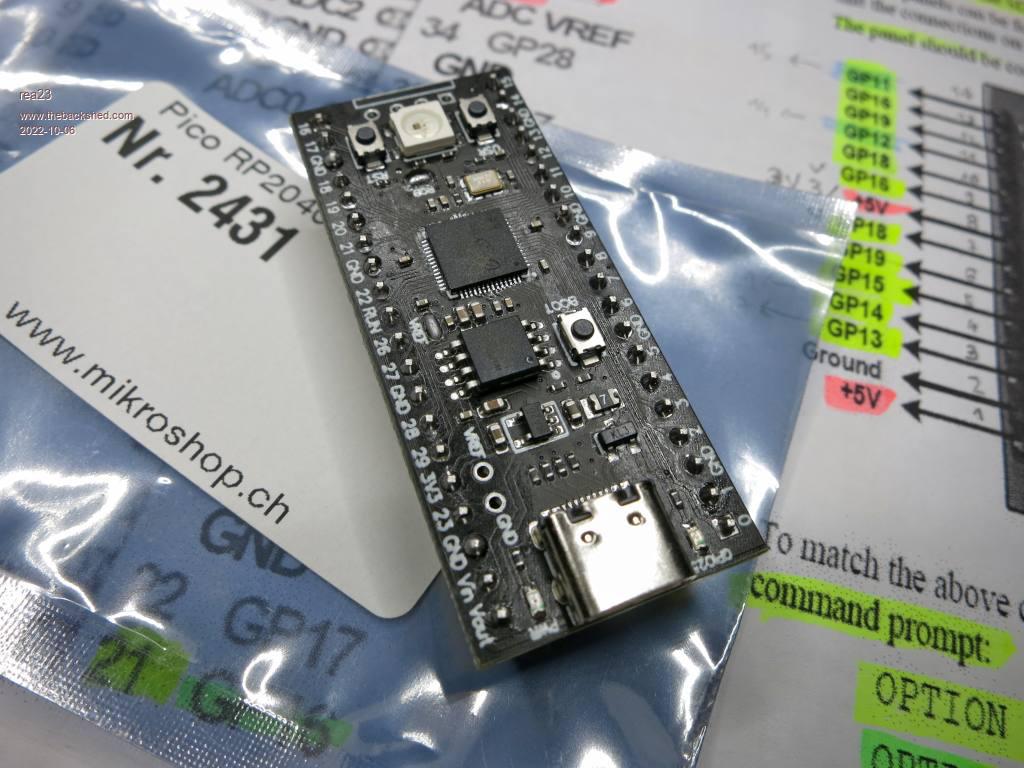
|

|
Forum Index : Microcontroller and PC projects : Flash Memory on Pi Pico
| Author | Message | ||||
| rea23 Newbie Joined: 16/09/2022 Location: SwitzerlandPosts: 26 |
Hi, maybe a stupid question. But is it possible to use the 2 MB flash memory of the pi pico to store/load a ranking list (two small text files), or an image pic.bmp of about 250 KB? So you don't have to use an SD card. By the way, i bought a pi pico that has a USB-C connector, an RGB LED, a user button and 8 MB QSPI (XiP) flash on board. https://mikroshop.ch/Home.html?gruppe=3&artikel=2431 This pin compatible pico runs as expected so far. The RGB LED is accessible via GP23 and the button via GP24.  |
||||
| Mixtel90 Guru Joined: 05/10/2019 Location: United KingdomPosts: 8304 |
No. You can't write files to the flash slots. They are for programs only as they store them tokenized. You can use flash to transfer variables using VAR SAVE and VAR RESTORE though, if that's of any use. Mick Zilog Inside! nascom.info for Nascom & Gemini Preliminary MMBasic docs & my PCB designs |
||||
| Tinine Guru Joined: 30/03/2016 Location: United KingdomPosts: 1646 |
USB-C  |
||||
| rea23 Newbie Joined: 16/09/2022 Location: SwitzerlandPosts: 26 |
@Mick: Thank you for the tip. This really helps, as I can at least wrap the rankings in two text variables. Still, it would be very helpful, if one could use the flash memory to store other files as well. Most of the time there is only one program installed on a PI Pico anyway (means one project per Pico). So then the flash memory remains essentially unused. This is even more the case when the capacity of the memory increases to 8, 16 or even more MB. |
||||
| Mixtel90 Guru Joined: 05/10/2019 Location: United KingdomPosts: 8304 |
It's not going to happen, apparently. :) The flash slots are *extremely* useful during program development, I've found, as you can keep incremental versions very easily. Because you can chain flash slots (keeping the variables) you can write a single program that's several times the size of the available memory! You could, for example, start your main program. That chains (it's almost like a GOSUB) another that configures a load of variables and stuffs an array or two then returns to the main program, which has remained in memory. SD cards are so easy to interface and use that, unless you are short of I/O pins and/or space, there's no real reason not to have one. If you are using a SPI display then you only need one more pin - and it can be any of them. Mick Zilog Inside! nascom.info for Nascom & Gemini Preliminary MMBasic docs & my PCB designs |
||||
| Mixtel90 Guru Joined: 05/10/2019 Location: United KingdomPosts: 8304 |
Agreed - but these things are all little extras that put the price up, which was why the original Pico doesn't have USB-C, apparently. Nice to have though. Mick Zilog Inside! nascom.info for Nascom & Gemini Preliminary MMBasic docs & my PCB designs |
||||
| robert.rozee Guru Joined: 31/12/2012 Location: New ZealandPosts: 2466 |
FLASH CHAIN n Runs the program in flash location n, leaving all variables intact (allows for a program that is much bigger than the program memory). Does not change the program memory. ... so as long as you can encode your data within basic statements, such as DATA "012...789,abc...xyz,ABC...XYZ" you can chain the flash slot with the particular set of data you want to use next, then at the end of the program in that slot chain back to the flash slot containing your main code. just use a flag to tell your main program that it needs to continue with the new data rather than starting afresh. with 0..9, a..z, A..Z, plus a couple of punctuation symbols, you have 64 possible unique symbols per byte, which gives a 75% memory usage efficiency (less the overhead of each DATA line). cheers, rob :-) Edited 2022-10-07 01:05 by robert.rozee |
||||
| The Back Shed's forum code is written, and hosted, in Australia. | © JAQ Software 2025 |